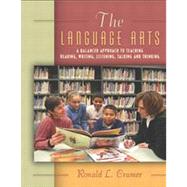
| Each chapter begins with ldquo;Chapter Openerrdquo; | |
| ldquo; A literacy storyrdquo; and concludes with | |
| ldquo;Practical Teaching Ideas and Activities,rdquo | |
| ldquo;Reflection and summary,rdquo; | |
| ldquo;Questions to Challenge Your Thinking,rdquo | |
| ldquo;A Case Study,rdquo | |
| ldquo;Return to the Anticipation Guide,rdquo | |
| ldquo;References.rdquo | |
| Foundations and Approaches to Teaching the Language Arts | |
| A Philosophy For Teaching the Language Arts | |
| Integrating the Language Arts | |
| Literature Based Language Arts | |
| The Influential Teacher | |
| 5A The Promise of Technology | |
| Three Approaches to Language Arts Instruction | |
| Organizing Learning Environments: Language, Learning, and Diversity | |
| Intellectual, Therapeutic and Cultivated Environments | |
| Classroom Management | |
| Creating Physically Inviting Environments | |
| 4A Environments For Developing Language, Thinking, and Meaning | |
| Environments Where Diversity Flourishes | |
| Assessing Writing and Reading | |
| Three Types of Assessment | |
| Principles of Assessment | |
| Assessing Writing | |
| Assessing Reading | |
| Standards, High stakes Testing, Accountability, and the Curriculum | |
| Listening and Talking | |
| Listening | |
| Talking | |
| Emerging Literacy | |
| Reading-Writing Relationship | |
| Literacy in the Home | |
| Emergent Writing Concepts | |
| Emergent Reading Concepts | |
| Assessing Emergent Reading and Writing | |
| Six Conclusions About Emergent Literacy | |
| Literature and Literacy | |
| 1A The Value of Literature | |
| Qualities, Quirks, and Issues in Children's Literature | |
| Literary Elements | |
| Genres of Literature | |
| 5A Response to Literature | |
| 6A Libraries and Children's Literature | |
| Reading Literature to Children | |
| The Story Teller's Art | |
| Content Literacy: Reading and Writing in the Content Areas | |
| Reading in the Content Areas | |
| Writing in the Content Areas | |
| Teaching Children to Comprehend Written Text | |
| Defining Comprehension | |
| Factors Influencing Comprehension | |
| Four Underlying Comprehension Components | |
| Thinking About the Commonly Named Comprehension Skills | |
| Comprehension Strategies: Before, During, and After Reading | |
| 6A The Role of Question Asking in Reading | |
| 7A Guided Reading | |
| 8A Helping Struggling Readers | |
| Word Study: Word Recognition, Dictionary, and Vocabulary Knowledge | |
| Word Recognition | |
| Dictionary Skills | |
| Vocabulary | |
| Writing Process in a Workshop Environment | |
| Graves' Writing Principles | |
| Writing Process Stages | |
| Writing Workshop | |
| Poetry for Children | |
| Preparing Children for Poetry | |
| Responding to Children's Poetry | |
| Sources of Inspiration for Writing Poetry | |
| The Language and Technical Devices of Poetry | |
| 5A Forms for Creating Poetry | |
| The Mechanics of Writing: Grammar, Punctuation, Capitalization, and Handwriting | |
| Grammar | |
| Punctuation and Capitalization | |
| Handwriting | |
| The Spelling Connection: Integrating Reading, Writing, and Spelling | |
| Integrating Reading, Writing, and Spelling Instruction | |
| Stages of Spelling Growth | |
| Approaches to Teaching Spelling | |
| Strategies for Teaching and Learning Spelling | |
| Instructional Issues | |
| Selecting Spelling Words | |
| Invented Spelling | |
| Assessing Spelling | |
| Table of Contents provided by Publisher. All Rights Reserved. |
The New copy of this book will include any supplemental materials advertised. Please check the title of the book to determine if it should include any access cards, study guides, lab manuals, CDs, etc.
The Used, Rental and eBook copies of this book are not guaranteed to include any supplemental materials. Typically, only the book itself is included. This is true even if the title states it includes any access cards, study guides, lab manuals, CDs, etc.